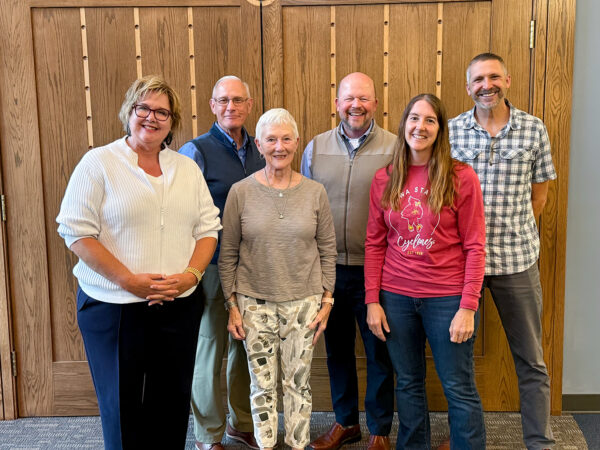Feeding college students
It all started with a bowl of strawberries – ripe, red fruit left behind for waste in a cafeteria at Augustana College.
Strawberries have a lot of tiny seeds on them, upwards of 200. These particular strawberries ended up planting seeds that grew into conversation, then thriving initiatives at the college.
Once a week, approximately 30 Augustana students visit the Campus Cupboard to shop for nonperishable food and personal care products, all for free. The cupboard also partners with a free ride service on campus to eliminate a transportation barrier, taking students to the grocery store.
Once a month, more than 100 students gather for a free, hot meal made from food otherwise headed to the landfill.
And throughout the year, Food Friends educate students, faculty, and staff about what to do if they encounter a student experiencing food insecurity.
“Oftentimes people define food insecurity too narrowly. Students have to fight the stereotype that all students live off Ramen noodles,” said Keri Bass, who works in the college’s office of Careers, Opportunities, Research and Exploration. She leads the Campus Cupboard. “If they are hungry, their brain power is taken up by thinking how they will feed themselves.”
This is what food insecurity sometimes looks like for a college student: To pay for food, a student works a job with long hours in a field unrelated to their interests – instead of taking part in an internship centered on career aspirations. The long hours often mean that the student has lower grades and fewer opportunities to be involved on campus and in the community. But if a student is fed, Keri said, she or he can focus on studies so that they can continue to build a thriving life.
Augustana College is mentioned in a recently released study as an example of a school that is working to alleviate food insecurity. The report, from a Wisconsin-based organization that focuses on improving outcomes in post-secondary education, made national news. The study is the largest known look at food and shelter security during college.
The Wisconsin HOPE Lab considered 43,000 students at 66 institutions (community colleges and four-year colleges and universities) in 20 states and the District of Columbia. They found that 36 percent of students at four-year colleges and 42 percent of community college students were food insecure in the 30 days preceding the survey.
“The data shows that basic needs insecurities disproportionately affect marginalized students and are associated with long work hours and higher risk of unemployment,” the study says. “However, the level of academic effort – in and outside the classroom – is the same regardless of whether or not students are dealing with food and housing insecurity. It is therefore critically important to match their commitments with supports to ensure degree completion.”
Students were asked to consider the following statements and questions about food insecurity:
■ I couldn’t afford to eat balanced meals.
■ I worried whether my food would run out before I got money to buy more.
■ The food that I bought just didn’t last and I didn’t have money to get more.
■ Did you ever cut the size of your meals or skip meals because there wasn’t enough money for food?
■ Did you ever not eat for a whole day because there wasn’t enough money for food?
■ Did you lose weight because there wasn’t enough money for food?
■ Were you ever hungry but didn’t eat because there wasn’t enough money for food?
On Thursday afternoons and evenings, the Campus Cupboard opens for business. The shelves of a former conference room are stocked with food such as canned fruits, vegetables, tuna, soups, as well as packaged noodles and snacks. Personal care products include toothbrushes and toothpaste, soap, shampoo, deodorant, and feminine hygiene supplies. The items in the pantry are provided by groups who run food drives, college and community members who give, as well as trips to the store to purchase things with money donations.
There’s no limit on what students can take, but most fill a backpack or so with food to help them get through the week, Keri said. When the cupboard first opened, some thought four or five students would come weekly. The reality is that more than 30 regularly stop by. The two barriers most often identified are money and transportation, Keri said. It gives Keri and the cupboard volunteers great joy to eliminate those barriers.
“We are a Christian college, and we are called to serve,” Keri said. “We celebrate the ability to respond to the needs of students.”





Suzy Schindler
There’s need in so many households – and dorm rooms. Bravo for filling that need.